花生壳基多孔碳负载Pd-Co催化剂应用于碱性介质中电氧化甲醇
2023-10-19霍朝晖韦雪蓉陈泽宇陈伟冰张绮彤温耿龙石俊杰
霍朝晖 韦雪蓉 黄 勇 陈泽宇 陈伟冰 张绮彤 张 刚 温耿龙 石俊杰
(1广东第二师范学院化学与材料科学学院,广州 510303)
(2广东高校先进材料与节能减排工程技术开发中心,广州 510303)
(3深圳方润环境科技有限公司,深圳 518107)
0 Introduction
Biomass is the most widely existing material on the earth,and all recyclable organic materials belong to biomass.In recent years,the preparation of new functional materials using biomass as raw materials had been a research hotspot,and biomass-based porous carbon is one of them[1-5].For example,Yu et al.[6]prepared a Co-loaded N-doped biochar electrocatalyst from sawdust,which exhibited excellent oxygen reduction reaction activity,higher stability (the current remained at 98.1% after running for 10 000 s),and methanol tolerance (the current remained 96.5% after adding methanol)than Pt/C.Rupa et al.[7]fabricated Ptdecorated Artocarpus heterophyllous seed-derived carbon as an anode catalyst for direct methanol fuel cell(DMFC) application.The prepared Pt/C showed excellent electrocatalytic activity in the potential range of interest with a high electrochemical active surface area(ECSA) of 261.4 m2·g-1.The advantages of using the listed above hydro char-derived carbon-based materials as a supported catalyst are lightweight,plentiful,cheap,porous,effective,non-toxic,and heat resistant,and they have a high surface area and a versatile nature.
Peanut shells as a kind of agricultural waste biomass,and their production is huge but only a little part of them were used to grow edible fungus,such as livestock feed,refined processing,supply exceeded demand,making the most of peanut shells became useless.Most of them were burned as waste or discarded as garbage,which constituted a burden on the environment.Therefore,it was necessary to exploit more applications of them.However,in today′s reports on peanut shell-based porous carbon,it is often applied in pollutant degradation or supercapacitor electrode materials[8-11].However,there are rare reports on peanut shells as the carrier material of DMFC anode catalyst.The peanut shells had a natural hole structure.KOH etching can further enrich its pore structure and make it have a high specific surface area and pore volume[12].It was believed that it is a potential DMFC anode catalyst carrier,which can be good for loading the active components in the catalyst.
Currently,most of the anode catalysts for direct methanol fuel cells is Pt-based catalysts[13-18].However,Pt is more abundant in natural reservations.Therefore,people begin to pay attention to Pd-based catalysts[19-20].Wang et al.[21]prepared a Pd-Ag/C catalyst by reducing Pd(NO3)2·xH2O and AgNO3with NaBH4,using carbon black as the carrier,which showed better electrocatalytic activity and anti-CO toxicity ability than Pd/C catalyst in alkaline methanol solution.Qiu et al.[22]prepared Pd and PdNi bimetallic catalysts,which loaded on carbon black using formic acid reduction.The average particle size was between 2-10 nm and Pd-Ni/C had higher catalytic activity for electrooxidation of methanol than Pd/C,indicating that Pd-Ni/C had a potential application in low-cost alkaline fuel cells.In addition to being cheaper than Pt-based catalysts,Pdbased catalysts were also competitive in electrocatalytic activity and anti-CO oxidization properties in alkaline media[21-23].Recent research shows that doping nonprecious metal Co in a palladium-based catalyst could effectively improve its electrochemical activity and stability[24-27].For instance,Zhang et al.[28]synthesized the catalyst for Pd-Co hybrid particles by two-step electrodeposition and template-free GRR (graphene random resistor) deposition in the template-based diethyl carbonate improving the methanol oxidation reaction catalytic performance.
Considering with the addition of Co can enhance the stability,electrocatalytic oxidation activity,and anti-CO toxicity ability of the Pd-based catalyst,and the peanut shell porous carbon (HC) obtained by chemical activation had a good pore structure[29],we prepared HC by the KOH activation method and then decorated Pd-Co nanoparticles to produce a DMFC anode catalyst with a low price and good electrocatalytic performance.
1 Experimental
1.1 Materials and methods
1.1.1 Materials
Peanut shell was purchased in the market.KOH was purchased from Tianjin Damao Chemical Reagent Co.,Ltd.CoCl2·6H2O and NaOH were purchased from Shanghai Aladdin Reagent Co.,Ltd.NaBH4was purchased from Shandong Xiya Chemical Co.,Ltd.HCl(37%) was purchased from Guangzhou Chemical Reagent Co.,Ltd.PdCl2(Pd content was above 60%)was purchased from Shandong Xiya Chemical Co.,Ltd.All reagents were analytical grade and used without further purification.
1.1.2 Synthesis of HC
4.0 g of cleaned,dried,crushed,and sieved peanut shell powder were placed into four beakers and added with flake KOH activator (The mass ratio of activator KOH to peanut shell powder was 0.5∶1,1∶1,2∶1,3∶1,respectively).Then,30 mL of distilled water was added and thoroughly stirred,followed by soaking for 12 h.After 12 h of immersion with a filter,the liquid was taken out from the sample,and then the sample was dried for 12 h in an 80 ℃oven to remove the remaining water and completely dry the sample.The dried sample was transferred to a crucible.Under a nitrogen environment,the sample was carbonized at 300 ℃with a heating rate of 5 ℃·min-1for 1 h.It was then further carbonized at high temperatures (600,700,800,and 900 ℃) for 1.5 h with a heating rate of 3 ℃·min-1.The muffle furnace was allowed to cool to room temperature,and then the carbonized sample was taken out.The obtained sample was immersed in 1 mol·L-1hydrochloric acid for 12 h.After washing with distilled water to neutrality,it was dried at 80 ℃for 12 h to obtain HCx-T,wherexrepresented the proportion of activator andT℃represented the activation temperature).HC0-Trepresented the non-activated HC.
1.1.3 Synthesis of catalysts
20 mg HC was put into a beaker and 20 mL of isopropanol-water solution (volume ratio of 2∶1),1.58 mL of 0.03 mol·L-1PdCl2solution,and 4.1 mg of CoCl2·6H2O were added,then the beaker with the solution was ultrasonically vibrated for 30 min.After this,the uniform solution was placed in a water bath.When it was heated to 70 ℃,1.0 mol·L-1NaOH solution was added under continuous stirring to adjust the pH to 10.0.Then slowly added the excess mass fraction of 5% NaBH4solution into the solution by dropwise and stirred it magnetically in a water bath at 70 ℃for 3 h.After the reaction,the product was washed and filtered many times with ultrapure water to remove unnecessary salt and reductant.Then the sample was dried in the vacuum drying oven at 120 ℃for 6 h and the Pd-Co binary catalyst was obtained.The theoretical palladium and cobalt loading (mass fraction) of the catalyst were 20% and 4%,and the catalyst was denoted as Pd-Co/HCx-T.Pd/HCx-Tand Co/HCx-Twere prepared by the same method,except for the addition of CoCl2·6H2O or PdCl2.
1.1.4 Structure and morphology characterizations
IRIS Advantage inductively coupled plasma atomic emission spectroscopy (ICP-AES) system (Thermo,America)was used to detect Pd and Co compositions of Pd - Co/HC catalysts.The emission lines wereλPd=340.458 nm andλCo=228.616 nm.The crystal structure and the chemical compositions of the catalysts were determined by using X-ray diffraction (XRD,working voltage of 40 V,working current of 25 A) analysis.The diffraction patterns of experimental catalysts were measured with a commercial diffractometer (Bruker D8,Germany) with a CuKαradiation source,λ=0.154 18 nm,at a scan rate of 3 (°)·min-1in a 2θrange from 10°to 90°.The structure and morphology of the materials were carried out by scanning electron microscopy(SEM,TESCAN MIRA 3 LMU,accelerating voltage 15 kV).The particle size and morphology of the Pd/HC and Pd-Co/HC were analysed by transmission electron microscopy (TEM,JEM-2100HR,Japan,accelerating voltage of 200 kV).For TEM characterization,the catalyst powders were ultrasonically dispersed in an ethanol solution to get uniform catalyst ink.After that,the catalyst ink was transferred onto copper grids covered with holey carbon film and dried in the air.The conductivity of HC was tested by the four-probe method(Shenzhen Crystal Lattice Electronics Co.,Ltd.ST2742B automated powder tester).Using an automatic specific surface adsorption instrument ([5.0.0.3] Belsorp,BEL Japan,Inc.Instrument),the N2adsorption isotherms were measured at -196 ℃,and the samples were outgassed at 180 ℃for 12 h before measurements.The specific surface area and the pore size distributions were obtained from the desorption branch of the isotherms by using the Brunauer-Emmett-Teller(BET)method and Barrett-Joyner-Halenda(BJH)analyses,respectively.The X-ray photoelectron spectroscopy (XPS) spectra were measured by a commercially available analyzer (Thermo ESCALAB 250XI,test energy 1 486.6 eV) and were used to analyze the compositions of samples.
1.1.5 Electrochemical measurements
A CS electrochemical workstation (A4602,Wuhan Kesite Instrument Co.,Ltd.) was performed using a three-electrode system which was prepared by dropping 20 mL catalyst sample (ultrasonic mixing 2.0 mg electrocatalyst and 100 mL absolute ethanol) on a clean glassy carbon (GC) electrode,a platinum electrode,and a saturated Ag/AgCl electrode (3 mol·L-1NaCl) as the working,counter,and reference electrodes,respectively.Cyclic voltammetry (CV) was performed in N2-saturated 0.5 mol·L-1NaOH solution or 0.5 mol·L-1NaOH and 1 mol·L-1CH3OH solution at room temperature.Chronoamperometry (CA) was measured in N2-saturated 0.5 mol·L-1NaOH and 1 mol·L-1CH3OH solution at room temperature and the potential was 1.0 V(vs NHE).
2 Results and discussion
2.1 Characterization of HC
Fig.1a shows the XRD patterns of HC prepared at 800 ℃with different dosages of activators.The XRD patterns of biomass carbon prepared at the five different dosages of activators were very similar.The two wide characteristic peaks at near 2θ=24.0° and 43.5°represented the (002) and (100) surface of graphite,respectively.The appearance of these two peaks indicated that the HC was amorphous[26].By comparison,with the increase of activator,the above two characteristic peaks became gradually weak.The peak of HC0-800 without an activator was the highest,which indicated that the activator KOH could corrode and destroy the material structure.With the increase of the dosage of the activator,the etching of KOH on the structure of HC was strengthened,which made the confusion degree of the sample structure increase and the graphitization degree decrease.
With the increase of activation temperature(Fig.1b),the above two characteristic peaks gradually became wide and weak.This was because the activator KOH could etch and destroy the material structure,and with an increase in the amount of activator,the damage to the porous structure of the peanut shellbased carbon by KOH was intensified,leading to an increased degree of disorder in the sample structure and a reduced degree of graphitization.
Fig.2a-2e are the SEM images of HC prepared at 800 ℃with different dosages of activator.Fig.2a represents HC0-800,which is the sample prepared without adding KOH for activation.Its holes were rare and the surface of the hole was relatively flat.Compared with other samples,we could find that with the KOH activator,the structure of the samples was etched,and the surface appeared many folds.According to the SEM images,HC0.5-800 had the most abundant hole structure.As the ratio of alkali to material increased,the samples′ aperture was bigger as well as the hole decreased,since the more amount of KOH,the stronger the etching ability of the sample.Excessive etching led to the collapse of the pore structure of the sample.
Fig.2f-2h are the SEM images of HC prepared at different activation temperatures,and the ratio of alkali to the material was 1.As shown in these figures,HC1-600 had only a few small holes and was not fully etched.HC1-700 had the most abundant pore structure.Starting from HC1-800,the holes began to decrease,and the aperture became large.It indicated that the activation ability of the KOH activator to HC increased with the increase of temperature,but when the temperature was too high,the activation ability was too strong,and the sample was excessively corroded,which led to the collapse of pore structure and the decrease of the hole and the increase of aperture.
Fig.3a was the adsorption-desorption isotherms of HC prepared with different contents of activator in liquid nitrogen at 77 K.When the relative pressurep/p0≤0.1,the nitrogen adsorption capacity of the five samples increased rapidly.According to the IUPAC classification of physical sorption isotherm,this is the characteristics of type Ⅰcurve,which represents the existence of the microporous structure.For HC0.5-800 in relative pressurep/p0>0.1,the nitrogen adsorption was saturated and almost did not increase.It is a typical typeⅠadsorption-desorption curve,which shows HC0.5-800 is mainly composed of micropores.While HC0-800,HC1-800,HC2-800,and HC3-800 adsorption curves were not consistent with the desorption curves with the emergence of a hysteresis loop.This is the characteristics of the type Ⅳcurve which means the four kinds of materials with a certain number of mesoporous.The hysteretic rings of HC0-800 belong to the H4 type,and that of HC1-800,HC2-800,and HC3-800 belong to the H3 type,which indicates that this material have an irregular pore structure[30].
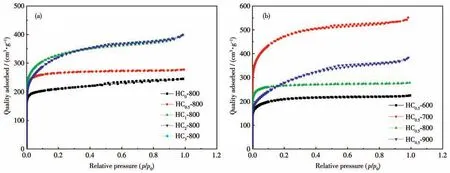
Fig.3 Nitrogen adsorption-desorption isotherms of(a)HCx-800 and(b)HC0.5-T
Fig.S1a (Supporting information) shows the pore diameter distribution curve of HC prepared with different dosages of activator.It could be seen from the figure,there were many micropores as well as a certain amount of mesoporous and a little macropores in all five samples.
Table 1 shows the pore information of the samples,including specific surface area(SBET,m2·g-1),average pore diameter (Davg,nm),and total pore volume(Vpore,cm3·g-1).As the increase of the dosage of the activator,the specific surface area of the sample first increased from 802 to 1 153 m2·g-1and then decreased to 865 m2·g-1(Table 1).As the increase of KOH dosage,the average pore diameter of the sample decreased.Combined with the SEM images and the result that the specific surface area of HC0.5-800 was larger than HC0-800,it indicated that the pores of HC0-800 without KOH activation were larger.However,with the alkali charge ratio of 0.5,many tiny pores appeared in the structure of HC0.5-800,so the average pore diameter was reduced.With the increasing amount of KOH,the aperture of the sample also increased,but was reducedwhen the ratio of alkali to material was 3.The total pore volume of the sample increased with the dosage of the activator but decreased when the ratio of alkali to the material was 3.It showed that when the ratio of alkali to material was 3,the pore structure collapsed.In conclusion,we can know that the proper amount of activator can effectively etch samples,promote the increase of pore structure,and increase the specific surface area and pore volume of samples,which is consistent with the results of SEM and XRD.
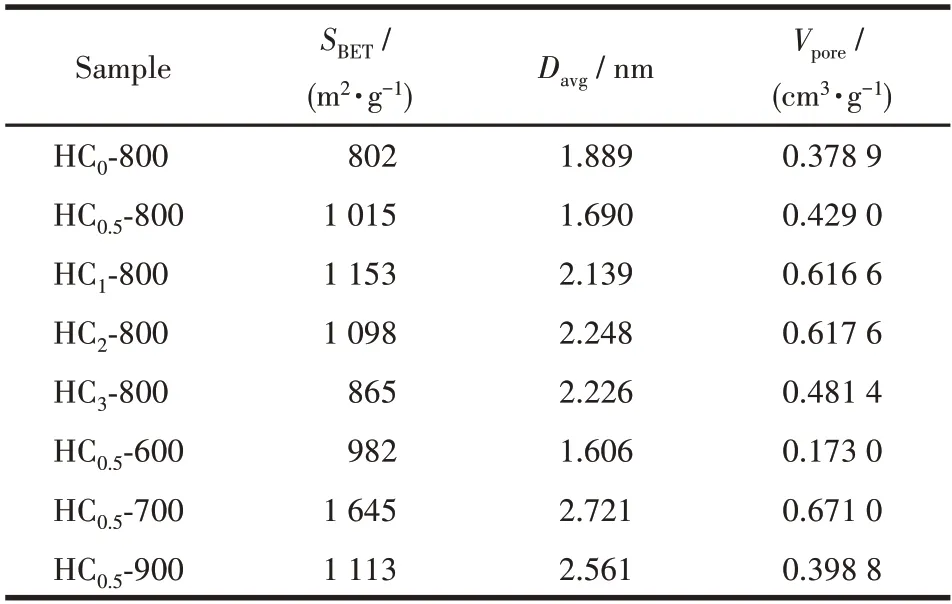
Table 1 Pore structure parameters of as-prepared HC
Fig.3b shows the adsorption-desorption isotherms of HC prepared at different activation temperatures in liquid nitrogen at 77 K.The adsorption-desorption isotherm of HC0.5-600 was a typical type Ⅰadsorptiondesorption isotherm.Therefore HC0.5-600 was mainly composed of micropores,and the adsorption-desorption isotherms of the sample HC0.5-700,HC0.5-800,and HC0.5-900 were type Ⅳcurves.When the relative pressurep/p0≤0.1,these three samples of the nitrogen adsorption capacity increased rapidly,which represents the existence of the microporous structure.The appearance of the hysteresis loop indicated that there were a certain number of mesoporous in these three materials.It is very important for the Pd-Co deposition with small size and uniform distribution.These three hysteresis loops all belong to H4 hysteresis.It shows that the material has an irregular hole structure[30].
Fig.S1b shows the pore diameter distribution curves of HC at different activation temperatures.All four samples had many micropores and a certain amount of mesoporous,HC0.5-600,HC0.5-800,and HC0.5-900 also had few macropores.
According to the pore information,with the increase in temperature,the specific surface area increased from 865 to 1 645 m2·g-1and then fell to 1 113 m2·g-1.The total pore volume first increased and then decreased,while the average pore diameter increased.It was consistent with the results of the SEM and XRD.In comparison with the reported similar Pd-Co/C systems,for instance,carbon black,pristine CNTs,and ball-milled CNTs[31],the specific surface area of HC is the highest.
The analysis of electrical conductivity was carried out by a 4-probe analyser.The pellets were delivered to the probe from a source of direct current (DC) by Keithley 2400 model.The electrical conductivity value was calculated from the obtained electrical resistivity values using Eq.1 for the electrical specific resistivity(R,Ω) and Eq.2 for the electrical conductivity (σ,S·cm-1).
whereArepresents the area of the pellet (mm2),andIrepresents the current density(mA).
The conductivity of biomass porous carbon carriers activated by NaOH measured by Celiktas et al.[32]using the 4-probe method is 4.24×10-3S·cm-1,we measured the conductivity of HC0.5-700 to be 4.73×10-3S·cm-1,it can be seen that the HC carrier activated by potassium hydroxide also has high conductivity and is a potential catalyst carrier.
2.2 Characterization of Pd-Co/HC
The practical compositions of the Pd-Co/HC0.5-700 catalysts were evaluated by an ICP-AES analysis.The Pd and Co content were 19.7% and 4.2% in weight,respectively.The obtained results are very close to the original theoretical values,indicating that Pd and Co could be co-reduced and that Co may be alloyed with Pd by such a synthesis method.
Fig.4a shows that there was a broad diffraction peak of graphite crystal plane (002)near 2θ=24° corresponding to the results of Fig.1.Pd/HC0.5-700 had diffraction peaks at 2θ=40.2°,46.9°,68.1°,and 82.5°,respectively,corresponding to crystal faces of Pd (111),(200),(220) and (311).This indicates that the Pd particles in the catalyst are presented with a face-centred cubic structure.By comparison,it was found that the diffraction peak positions of Pd-Co/HC0.5-700,2θ=40.3°,47.0°,68.2°,and 83.1° were shifted to a higher angle than Pd/HC0.5-700.Matching with the standard card,it was found that these peaks matched with the standard card Pd (PDF No.87-0645) (Fig.S2).It was proved that it comes from CoPd2,and the peaks correspond to the (111),(200),(220),and (311) crystal planes of CoPd2,respectively.This indicated that Co enters the crystal lattice of Pd in the prepared catalyst and forms a Pd-Co alloy.The appearance of Pd-Co alloy caused the Pd diffraction peak of Pd-Co/HC0.5-700 to shift to a higher angle.
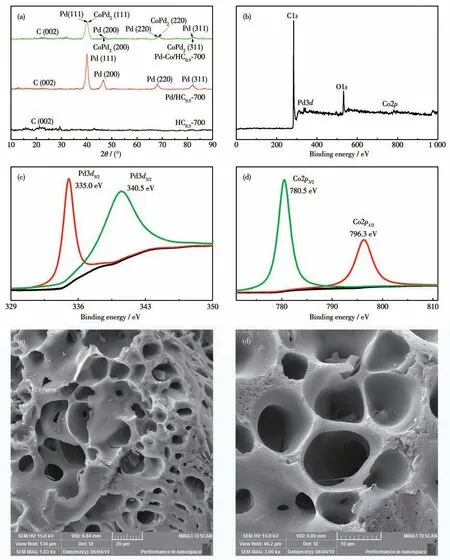
Fig.4 (a)XRD patterns of Pd-Co/HC0.5-700,Pd/HC0.5-700,and HC0.5-700;(b)Survey,(c)Pd3d,and(d)Co2p XPS spectra in Pd-Co/HC0.5-700;(e,f)SEM images of HC0.5-700
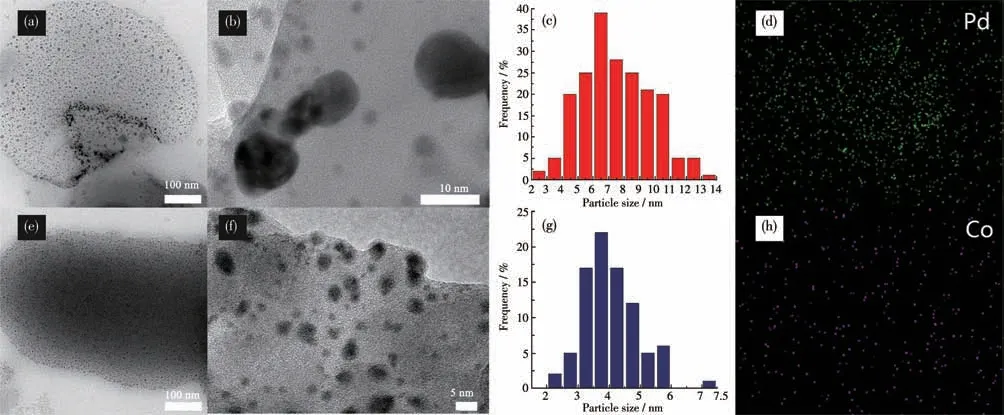
Fig.5 (a,b,e,f)TEM images and(c,g)the corresponding particle size distribution histograms of(a-c)Pd/HC0.5-700 and(e-g)Pd-Co/HC0.5-700;Elemental mapping images of(d)Pd and(h)Co elements for Pd-Co/HC0.5-700
The average crystal size (D) of Pd-Co/HC0.5-700 and Pd/HC0.5-700 were calculated as 4.8 and 7.7 nm respectively by the Scherrer formula and crystal surface of Pd (111),which indicated that the addition of Co could effectively reduce the crystal size of the catalyst.
whereλ(nm) was the X-ray wavelength (0.154 18 nm),βwas half peak width,θwas the diffraction angle.
Fig.4b shows the XPS survey spectrum of Pd-Co/HC,in which the peaks of 284.0,335.7,531.8,and 780.5 eV correspond to C1s,Pd3d,O1s,and Co2p,respectively.Fig.4c represents that the peaks of 335.0 and 340.5 eV correspond to the peaks of 3d5/2and 3d3/2of Pd(0) respectively.Fig.4d exhibits that the peaks of 780.5 and 796.3 eV correspond to the 3d3/2and 3d1/2peaks of Co (Ⅱ)respectively.Based on the XRD patterns,Co in the catalyst is mainly in the form of Co and CoO.
Fig.4e,4f and 5 show SEM images of HC0.5-700 and TEM images of Pd/HC0.5-700 and Pd-Co/HC0.5-700 catalysts and their corresponding particle size distribution histograms obtained by observing more than 200 nanoparticles.It was apparent that all the Pd monometallic or Pd-Co alloy catalysts were well dispersed in the pores of basal porous carbon,and the particle size distribution was relatively narrow.With the addition of Co,the average particle size decreased,and the average particle diameters of Pd/HC0.5-700 and Pd-Co/HC0.5-700 catalysts were about 7.5 and 4.1 nm,respectively,which was consistent with the XRD results.Two reasons for the appearance of small-sized Pd-Co nanocrystals can be explored: (1) NH4F as a complexing agent with Pd2+ions for the co-reduction of Pd2+and Co2+ions in an aqueous solution at low-temperature heating,thus much smaller nanoparticles could be avoided when annealing.(2)The HC offer a high specific surface area with plenty of mesopores (or porous configuration) effectively avoiding aggregation.The obtained small particle size may be beneficial to increase the methanol electrooxidation activity.The element mapping analysis reveals the existence of the Pd and Co elements in the architecture which are all evenly suspended throughout HC0.5-700.
Because of the appropriate pore structure of HC0.5-700,the Pd-Co catalyst prepared with HC0.5-700 as a carrier had the best electrocatalytic activity (Fig.S3-S7),therefore the subsequent electrochemical analysis would be conducted with Pd-Co/HC0.5-700.
Pd-Co/HC0.5-700 and Pd/HC0.5-700 had a reduction peak at near 0.56 V (vs NHE) which comes from PdO and Co/HC0.5-700 had a reduction peak at 0.62 V(vs NHE) coming from CoO (Fig.6a).The integral area(S) of these reduction peaks could be used to calculate ECSA of the catalyst,which showed in Eq.4 and 5[33-34].
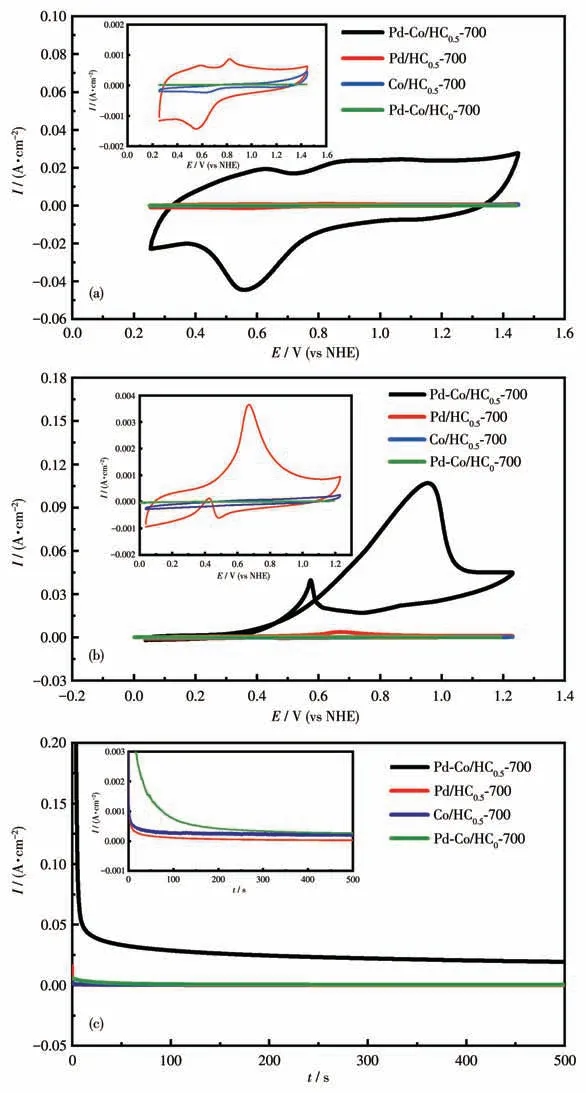
Fig.6 (a)CV curves of Pd-Co/HC0.5-700,Pd/HC0.5-700,Co/HC0.5-700,and Pd-Co/HC0-700catalyst in 0.5 mol·L-1 NaOH solution at 110 mV·s-1;(b)CV curves of Pd-Co/HC0.5-700,Pd/HC0.5-700,Co/HC0.5-700,and Pd-Co/HC0-700 electrodes in 1 mol·L-1 CH3OH solution with 0.5 mol·L-1 NaOH at 50 mV·s-1;(c)CA curves of Pd-Co/HC0.5-700,Pd/HC0.5-700,Co/HC0.5-700,and Pd-Co/HC0-700 electrodes in 1 mol·L-1 CH3OH solution with 0.5 mol·L-1 NaOH at 1.0 V(vs NHE)
whereQis the amount of charge required for the oxide to be reduced,which can be calculated by Eq.5.In other words,theScan be obtained by integrating the oxide reduction peak,and then the value ofQcan be obtained by dividing it by the scanning speed (v).Cis the amount of charge required for the reduction of monolayer oxide,its value is 4.05 C·m-2.mis the load of oxide.
According to Eq.4 and 5,the ECSA of Pd-Co/HC0.5-700,Pd/ HC0.5-700,and Co/HC0.5-700 catalysts were 329.63,10.67,and 6.32×10-5m2·g-1,respectively.The ECSA of Pd-Co/HC0.5-700 was also higher than that of Pd-Co/XC-72 (32.62 m2·g-1)[34].Pd-Co/HC0.5-700 had the highest electrochemical activity,due to the smaller particle size and the formation of relatively rough surfaces during alloying.
Fig.6b,6c display the CV curves on the Pd-Co/HC0.5-700,Pd/HC0.5-700,Co/HC0.5-700,and Pd-Co/HC0-700 electrodes at a scan rate of 50 mV·s-1in the solution of 1 mol·L-1CH3OH and 0.5 mol·L-1KOH.The methanol electrooxidation on the electrode of the present investigation,especially on the Pd-Co/HC0.5-700,was characterized by two well-defined anodic current peaks: one in the forward (i.e.,anodic condition,denoted:If) and the other one in the reverse scan,denoted asIr.In the forward scan,the oxidation peak is corresponding to the oxidation of freshly chemisorbed species coming from methanol adsorption,which reflects the electrocatalytic activity of the catalyst[35-37].The oxidation peak in the reverse scan is primarily associated with the removal of carbonaceous species not completely oxidized in the forward scan than the oxidation of freshly chemisorbed species[31,38-39].
As shown in Fig.6b and Table 2,theIfof Pd-Co/HC0.5-700 was 1.07×10-1A·cm-2,significantly higher than that of Pd/HC0.5-700,Co/HC0.5-700,and Pd-Co/HC0-700 which were 3.65×10-3,5.71×10-5,and 2.92×10-5A·cm-2,respectively.TheIfof Pd-Co/HC0.5-700 was 29.3 times higher than that of Pd/HC0.5-700,which was also better than that of the reported ball-milled MWNT-supported Pd-Co catalyst[31].Adding Co can facilitate the removal of CO from the surface of the Pd-Co/HC0.5-700.To be specific,according to the bifunctional mechanism,the Co - activated water at lower potentials than Pd,and the activated water could oxidize the adsorbed CO and therefore liberate Pd active sites[31].This can help to explain why the Pd-Co/HC0.5-700 has a higher activity for the oxidation of methanol.It should be noted an acidic environment resulted in leaching out of the surface Co species while leaving a rough Pd skin layer with an underlying alloy structure[40].However,Co species in an alkaline environment can remain intact on the surface to provide oxygencontaining species for methanol oxidation at a lower potential.
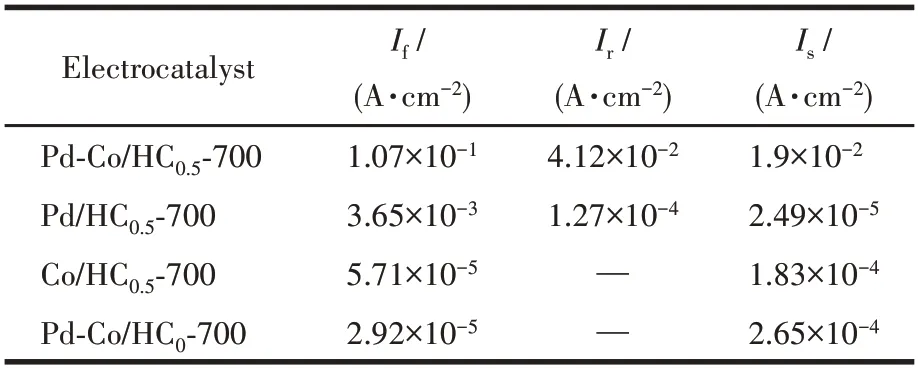
Table 2 If,Ir,and Is of the catalysts
The ratio ofIf/Irfor Pd-Co/HC0.5-700 was 3.3,which was also much better than that of the reported ball-milled MWNT-supported Pd-Co catalyst[31],maybe due to the large surface area and the rich porous structure of the prepared HC.In general,the larger the ratio ofIftoIr,the better the performance of the catalyst may be.Because theIris attributed to the removal of the incompletely oxidized carbonaceous species formed during the forward scan,these carbonaceous species are mostly in the form of linearly bonded Pd=C=O[41].Therefore,the larger ratio ofIftoIrin CV for the oxidation of methanol proves that the catalyst possesses better electrocatalytic activity and anti-CO poisoning.
CA results (Fig.6c) shows the current density of all catalysts decreased rapidly at first and then stabilized because of the toxic intermediate product such as CO during methanol oxidation,and the inevitable oxidation of metal Pd.As the testing proceeded,a pseudosteady state was gradually attained.Adhesion of CO to the catalyst would lead to the decreased activity of the catalytic.The more seriously the catalyst poisoning,the smaller the final steady-state current density.Therefore,CA was commonly used to test the anti-CO poisoning ability of the catalyst[31,35-37].The current density of Pd-Co/HC0.5-700 was higher than Pd/HC0.5-700,Co/HC0.5-700,and Pd-Co/HC0-700 (Table 2,represented the starting current in CA) over the whole time,confirming that alloying of Pd with Co improved the efficiency and poisoning tolerant of Pd/HC0.5-700.The enhanced catalytic activities observed in the case of the Pd-Co may be attributed to the alloying of Pd with Co followed by a lattice compression.The lattice compression results in a shift of thed-band center,which affects the surface activity of Pd sites[42].It has already been shown by density functional theory calculations that the compression of a Pd lattice in alloy produces the downshift of thed-band center energy[43-44].It meant the anti-CO toxicity ability of Pd-Co/HC0.5-700 was the best,indicating that doping Co in the Pd catalyst can effectively improve the anti-CO toxicity ability of the catalyst.
To further test the anti-CO toxicity ability and longterm stability of Pd-Co/HC0.5-700 and Pd/HC0.5-700 catalysts,1 000 cycles of CV were performed.The ratio of the forward anodic peak current density (In) of thenth CV cycle to the forward anodic peak current density(I0) of the first cycle was used to evaluate the long-term stability of the catalyst[45].During the first 100 cycles,theIn/I0of Pd-Co/HC0.5-700 and Pd/HC0.5-700 both increased with the increase of cycle number,but the ratio after that decreased.The reduction rate of Pd-Co/HC0.5-700 catalyst was significantly smaller than Pd/HC0.5-700 catalyst (53.39% and 83.2%,respectively) in Fig.S3.After 1 000 cycles,I1000/I0of Pd-Co/HC0.5-700 was significantly higher than that of Pd/HC0.5-700 (1.088 and 0.564 0,respectively).The experimental results showed that the anti-CO toxicity performance and longterm stability of Pd-Co/HC0.5-700 were exceedingly better than that of Pd/HC0.5-700,indicating that the addition of Co can effectively improve the stability and anti-CO toxicity ability of the catalyst.It is consistent with the experimental results of CV and CA mentioned above.
The high electroactivity of the Pd/HC0.5-700 can be described owing to the following reasons.(1) The HC offer a high specific surface area with plenty of mesopores (or porous configuration).(2) The bimetallic Pd-Co nanostructure presents a shift in the d-band center of Pd which has some contribution to the surface activity of Pd sites and poisoning of Pd active sites is decrease[46].(3)The addition of Co promotes the concentration of OH-,which is required for the desorption and oxidation of the adsorbed intermediates,at lower potentials.This accordingly enhances the kinetics of alcohol oxidation[44,47].The lowest catalytic activity of Pd-Co/HC0-700 is because the porous carbon pore structure of the unactivated peanut shell base is not rich and the specific surface area is low,which cannot provide sufficient active sites for Pd-Co.The comparison of different electrocatalysts for methanol electrooxidation is in Table S1.
3 Conclusions
HC with a large specific surface area and rich pore structure was successfully synthesized using the KOH activation method.The HC as the carrier was first applied to the DMFC anode catalyst.With the doping of Co,the Pd-Co/HC catalyst showed much more excellent electrocatalytic activity,better CO tolerance,and long-term cycle stability than Pd/HC.The application of abandoned biomass and the obtained Pd-Co/HC catalyst provides a promising anodic electrocatalyst for DMFC and can be applicable in products.
Acknowledgments: This work was financially supported by the Guangzhou Basic and Applied Basic Project (Grant No.202102020424),Innovation and Entrepreneurship Training Program for College Students (Grant No.S202214278030),Special Fund for Scientific and Technological Innovation Strategy of Guangdong Province (“Climbing” Program,Grant No.pdjh 2022b0385),Key Scientific Research Projects of General Universities in Guangdong Province (Grant No.2021KCXTD086),Characteristic Innovation Project of Colleges and Universities in Guangdong Province(Grant No.2022KTSCX090).
Supporting information is available at http://www.wjhxxb.cn
